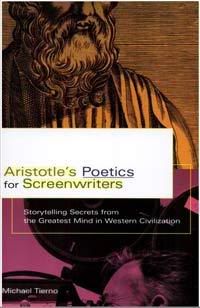

I got both of these recently and I'm very impressed with them both. Click the pics to go to Amazon, where you can search inside both books and read reviews to determine if it sounds like something you'd like.
I've read several books on screenwriting, and there's some info that's almost universal to them.... and as I now know, it's essentially the story structure handed down to us by Aristotle. Michael Tierno knows his Aristotle, and is adept at translating his immortal words so we can understand it the way he intended. At one point I intended to buy the Poetics book in translation, but as many people have learned, it's very opaque and difficult to understand. Tierno does an excellent job of explaining exactly what the Stotle-meister meant by each of his mysterious utterances and how they apply to today's drama, which DOESN'T include naked choruses and dithyrhambic chanting!
Apparently a lot of people misunderstand Aristotle's ideas, and a lot of screenwriting books are based on these misunderstandings. Looking around the web a bit I see a lot of hate for the 3-act structure - mostly by people who seem more focused on equal length for each act rather than the actual functions of them. Well this book gets right to the basics.... it doesn't dwell on number of pages per act or length of screen time between turning points. Instead it goes into the drama itself.... how to set it in motion effectively so that people clearly understand what's happening and what needs to be accomplished, and how to resolve it so there are no lingering questions and so it makes a powerful emotional connection with the audience.
I know.... for making short animated films we probably don't need to use Aristotlian story structure! But I believe before you can effectively bend the rules to your own purposes it's good to learn them first, otherwise you're operating from sheer ignorance. When you know the rules, you can manipulate them the way you want - and when you've absorbed Aristotle's awesome wealth of knowledge about what makes drama work you have a much stronger understanding of how to tell a story. I believe even if you want to do more experimental films it's still important to understand how to give an audience what it wants.
The Visual Story is about how to use visual elements to accent the flow of your story. Verticals, horizontals, diagonals, flat space and deep space, color..... these are all powerful visual elements that every filmmaker (every visual artist in fact) uses all the time, whether they think about it or not. And when you DO think about it, they can be used intelligently to make your film affect people the way you want it to, rather than working against you.

1 comment:
I don't know what I'd do without your taking complex concepts and breaking them down so that I can understand them.
I bought the Visual Story based on your recommendation and am loving it, thank you. I know a lot of copies were sold because of your pointing the way. And a lot of films will be better as a result.
Post a Comment